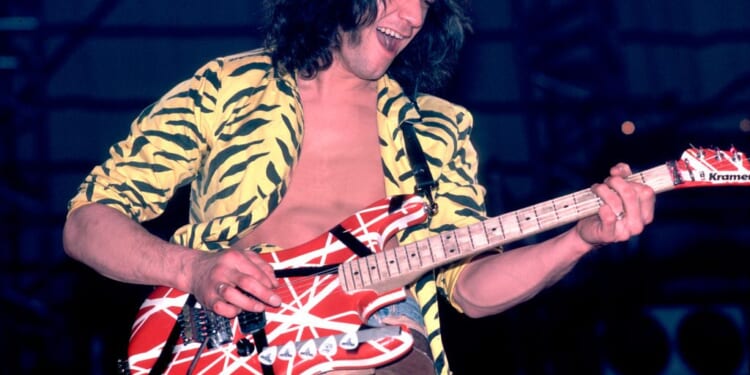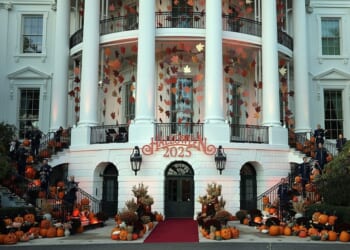“We take a jazz philosophy approach to music,” Warren Haynes tells me, sitting in his trailer before a concert in Chicago. He should know: the lead singer and guitarist of Gov’t Mule, Haynes has also played with the Allman Brothers Band for 23 years, and toured with the Grateful Dead, even taking on the quasi-sacred role of the late Jerry Garcia. Given Mule’s own hectic blend of styles, from hard rock to soul, his emphasis on jazz-like freedom makes sense. It also explains why Haynes associates his band with the “jam rock” label, wryly calling his outfit the genre’s “black sheep”.
That term “jamming” isn’t one you hear much these days, with the concept it evokes largely unfamiliar to those millions of Americans trapped by mainstream pop culture. But during a period of greater artistic freedom and exploration, it influenced and inspired the best of American music. Over 60 years ago, as young people railed against stultifying postwar convention, musicians waged their own sonic revolution — assailing the predictable, formulaic three-minute structure of the pop song. Bands that “jammed” played according to an impromptu ethos, never performing the same version of the same song twice.
Initially inspired by jazz, blues and the beat poets, jam rock defined itself in defiance of static convention, adopting an anti-corporate posture in its songwriting, live performance, and political attitude. The disappearance of the jam ethic from American music is congruent with the emergence of a pop culture that is increasingly dull, the product of sophisticated, technologically enhanced marketing techniques; social media campaigns of manufactured virality; and algorithmic approaches to everything from composition to stage costumes. It all turns music into the sound of the machine — with jam rock, what survives anyway, clinging on as the soundtrack of the human heart.
A jam, according to Haynes, is a “musical conversation”. It is the sound of music being made, composed on the spot, rather than merely played. Listen to “Whipping Post” on The Allman Brothers’ Live at Filmore East album, the Grateful Dead playing a lengthy “Scarlet Begonia” that beautifully segues into “Fire on the Mountain”, or even Led Zeppelin’s 20-minute version of “Dazed and Confused” — and you’ll enter a musical world where brilliant musicians play without a safety net, listening only to each other to learn the next cue, hook, key change, or measure, and managing, as if by magic, to create something in the moment that is unique, accomplished, but subject to change the very next night.
Disciplined freedom and composition by conversation are principles Haynes highlights throughout our discussion. “Even with the simple songs and arrangements, we take a different approach night by night,” he says. That’s true, he continues, even for songs “we’ve played many times before”.
Mule themselves showcased their exercise of the jam philosophy with their Chicago rendition of “Rocking Horse”. Originating in 1995, the mid-song instrumental jam is a chameleon, sometimes sounding like jazz funk — or, as it did in Chicago, exploding with heavy artillery that makes it easy to understand why James Hetfield, lead singer of Metallica, has named it one of his favourite songs. The jam is an aural representation of a commitment to spontaneity, with Haynes explaining that the greatest jam bands strike the balance of The Grateful Dead and The Allman Brothers, who could jam but also had well-structured songs. “It’s not just noodling,” he says.
The heady blend of the genre-defying jam soon transcended Sixties icons like The Grateful Dead. By the Seventies, jamming not only created its own scene, but also became a critical part of the live performances of Santana, Neil Young and Crazy Horse, Parliament-Funkadelic, and even the Rolling Stones, whose four-minute musical outro of “Can’t Your Hear Me Knocking” was improvised in the studio. By the Eighties, the Grateful Dead were selling out stadiums; through the Nineties, when Gov’t Mule made its debut, the scene continued to grow with bands like Widespread Panic, Dave Matthews Band, and Phish all building large audiences. Each developed their own identity. Panic, for instance, plays swampy southern rock, while DMB blends saxophone and violin in energetic musical interludes that complement Matthews’ emotive vocals.
Yet if the music itself is clearly part of the appeal, jamming was always about much more. As Jim Newton argues, it’s indicative of the freedom and imagination of American culture at its best. As the scholar of Sixties counterculture explains, that includes guitarists and vocalists, but also luminaries from Kurt Vonnegut to Jane Fonda. “They sensed an absence,” Newton writes of these early pioneers in his book on the subject, “that society had gone terribly wrong, and that it was time for something new — a life less rooted in reason, more accessible through vision, magic.”
That cultural context is something that the musicians themselves have often acknowledged. Explaining his band’s popularity in the Eighties, Jerry Garcia attributed the swelling crowds to people “searching for an alternative to passionless America.” When I quote that line to Haynes, he says that the jam scene still displays “opposition by example” to an America suffering from a deficit of passion. And, certainly, if it was easy to see what Garcia meant back then, amid the cheap consumerism of Reagan’s America, those flocking to see bands like Gov’t Mule today are in even more desperate need for some magic.
The fact is that modern American culture is placid, unmoving, diluted. In the contemporary commercial landscape, algorithms direct wide-eyed social media users to songs, movies, podcasts, “reels”, all frantically different, but each increasingly resembling one another. And music is, perhaps, the worst casualty of the new consumer culture. Beyond the fading fortunes of rock, after all, pop music has become narrow to the point of claustrophobia. In previous decades, pop radio made room for Prince, Elton John, and Joni Mitchell — artists who, Haynes argues, “expressed themselves on a much wider, diverse plane than anyone in pop music today.”
“Modern American culture is placid, unmoving, diluted.”
Now, though, pop and rock alike increasingly devolve into autotuned, machine-programmed jingles, each indistinguishable from the next. It wasn’t too long ago that a sound engineer proved that nearly every recent hit of another genre, country, used the exact same musical formula. In fact, by mixing one top of the other, the engineer demonstrated that each song was practically identical. Haynes adds that many younger musicians would balk at the jam-rock principle of performing without much rehearsal. Instead, they carefully plot and plan every note. “There is less desire to be unique,” he says, “and more of a desire to become famous.”
At the same time, Haynes argues that the dreariness of modern music has an impact on the listener. Haynes is 65 — and I’m 25 years younger — but our conversation conjured similar memories for us both: searching for bootleg live recordings at independent record stores; trading burned CDs of underground releases with friends; scavenging the internet for long-lost studio outtakes. “We both grew up at a time when we had to seek out good music,” Haynes says, “and when you found something you liked, it made a big impact.”
Yet as music has become more ephemeral and accessible, it has lost its magic. The average consumer, instead of navigating their own adventure with music, obeys the all-pervasive algorithm. It is a cliché, but one with a fair amount of justification, to argue that music is “America’s best export”. Formulaic songs, then, provide an unfortunate but accurate accompaniment to an era when most Americans believe that the country’s best days are long gone, politicians compete with various versions of nostalgia, and the larger culture, from fashion to film, reproduce money-making hits according to the same methodology, whether it is endless iterations of athleisure wear or the latest superhero blockbuster. A trend that has triumphed in American architecture, square buildings with identically grey facades, is aptly called, “blanding.” How sad for a society that once challenged the world with its inventiveness.
Cultural stagnation drains the power from music, while also generating a broader society of passivity. Woodstock, most famously, was not only a music festival, but something of a countercultural convention, where Jimi Hendrix played a distorted version of “The Star Spangled Banner” as a protest against racism and the war in Vietnam. Despite all that, and how the Grateful Dead became a roving alternative to Eighties commercialism, few bands are so ambitious these days, with the decline of jamming reflecting a culture where more and more Americans meekly accept the putrid consensus in culture and politics alike. The only song protesting the reversal of Roe v. Wade was written by Stevie Nicks: and she’s 77.
When I observe that fewer popular musicians appear willing to express genuine political thought, Haynes agrees. “It’s an internet thing,” he says, “and a cancel culture thing. People don’t want to risk what they have to voice their opinions. The environment breeds comfort with the status quo.”
Despite the economic and political pressures to quietly conform, something of the old rebellious culture endures today. Early in their Chicago set, Gov’t Mule launch into a rollicking performance of their 2017 epic “Revolution Come, Revolution Go”. The lyrics depict a society facing vast upheaval, while casting contempt on America’s corrupt political class. “Lying to the people about some new deal,” Haynes cries, “chump change happens every day!” The music itself carries the audience along, the transitions from metal to hard bop reflecting America’s shifting fortunes.
All the while, the genre’s broad decline has arguably brought America’s surviving jammers closer together. That night in Chicago, I met obsessives who have seen their favourite band dozens of times, as they study the nightly live recordings available online, and collect the funky, artistic posters unique to each show. And if everyone is chasing an extended version of their favourite song, or hoping for the live debut of an especially obscure track, to both performers and consumers the jam music scene is a thoroughgoing community: one just as framed by freedom as its Sixties forebear.
When I ask one 20-something woman in a sky-blue sequinned skirt and black combat boots why she preferred bands like Gov’t Mule to the mass marketed pop superstars of her generation, her answer is simple. “It’s just more real,” she says. “It’s just more emotional.” Her ecstatic dancing from the opening to closing notes animated her point.
While mainstream music has lost much of its vitality, authenticity and creativity seem harder to kill. Indeed, the jam music scene has recently attracted a slew of younger fans, whether they’re drawn to traditional jam outfits like Goose; Jackie Venson, who blends Prince-like guitar tones with synthesiser ambiance in free-wheeling pop-blues jams; or the bluegrass guitarist Billy Strings. Goose and Billy Strings sell out basketball arenas, playing to tens of thousands of fans, and Dave Matthews continues to play large, outdoor venues each summer to cross-generational crowds of college students and Gen-X professionals. When I caught up with Haynes, Gov’t Mule was on a co-headlining tour with The Tedeschi Trucks Band, a popular jam band formed in 2010.
Despite the vibrancy of the jam world, insiders like Haynes are concerned for the future, especially given the introduction of AI to an already-digital music world. “If people use it in a creative way,” he says, “it could be amazing, but if people use it to save themselves work and steal other people’s ideas, then it will just be creepy.” That creepiness has already permeated into pop culture with fake songs from phony bands gaining popularity on social media. Digital impostors are the logical endpoint of auto-tuned vocals, click-track drums, and computer-driven song arrangements, all of which makes it difficult to even call much of what happens on music awards shows “performance”.
If America has become too uptight and cautious, and if a jam is a loose, improvisational effort in spontaneity and artistry, one of the most salient questions of our era surely becomes: can we make America jam again? A highlight of my night in Chicago was collaboration between Mule and members of Tedeschi Trucks Band on the Grateful Dead staple “Shakedown Street”. In the middle of an ecstatic 10 minutes, Haynes played a fiery, heartfelt guitar solo. As the song moved toward its conclusion, he sang with fearless passion, offering the song’s signature lyric as a plea and a promise for a fragmented culture struggling to rediscover its own spirit of creativity: “Don’t tell me this town ain’t got no heart / You just gotta poke around.”

















